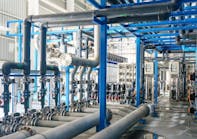Q
A customer has a weekend cabin with a shallow well. Iron has been tested between 10 and 25 ppm. Is there any system that I can use to just remove the iron so that the customer can install a water heater and use the shower? It needs to be a system that can be taken offline in the winter and stored in the basement so it does not freeze.
A
High concentrations of iron are hard to remove in any case, but this is particularly difficult due to the seasonal and occasional nature of the water use. I am going to assume that most of the iron is ferrous (Fe+2), but you should perform more testing to pin down the concentration a little better.
In general, there are about four different approaches to iron removal. Ion exchange can be used when it is also desirable to remove hardness or other cations. Since you only want to remove a high concentration of iron, I don’t think ion exchange is practical.
There are oxidizing filters whereby iron is oxidized and filtered in the same bed. The most common of these uses manganese greensand as the media. It requires frequent regeneration with a potassium permanganate (KMnO4) solution. I don’t recommend this due to the infrequent usage of the filter. Without frequent backwashing the greensand is very likely to harden thereby becoming useless and almost impossible to remove from the tank.
There are a few catalytic media which can remove iron without the need for a regenerant. One popular example is the material called Birm. If the iron concentration were about 10 ppm, you could have a very simple filter containing Birm or similar catalytic media that only needs backwashing. But with a higher iron level, this and the greensand both have a drawback, which is that there is nothing to adjust if the oxidation is not complete.
Preferred would be a “system” which consists of oxidizing what I’m assuming is mostly dissolved iron, Fe+2, to filterable ferric, Fe+3. Once oxidized, the iron can be filtered as particulate matter. Common oxidizers include chlorine, ozone, hydrogen peroxide, air (as an oxygen source), potassium permanganate and chlorine dioxide. Of these, the ozone and peroxide are the most powerful and fastest acting. A contact tank might not be required if the dose of oxidizer is great enough. This is field-adjustable and very desirable with the high iron conditions. A backwashing sediment filter is needed to remove the precipitated iron. Several media can be used for this, including the popular multi-layered filters.
As you probably know, much more information will be needed in order to design a proper custom system for this customer. The guidelines I have presented above are very generalized due to a lack of data. I recommend that you work closely with one of your equipment suppliers so they can help make a tailored system. You will need a complete water analysis, a more specific iron concentration, an agreement with the customer on minimum acceptable flow rate, a study of installation space and an off-season storage plan.
Q
On the Water Technology website, WaterTechOnline.com, I recently read on the Bulletin Board forum that new water softening resin has very little capacity until it is regenerated several times. I wasn’t aware of this until now so I want to know how many regenerations are required to achieve full capacity. Can you help?
A
To quote an often used saying, “Don’t believe everything you read on the Internet.” This is one case of that. It is disappointing to see someone responding to a question that doesn’t really know the answer, but probably is repeating a bit of hearsay, with good intentions, that is incorrect.
The resin in question has a capacity per cubic foot, when new, of about 44,000 grains, usually specified as 2.0 eq/L (equivalents per liter). Also, note that this is greater than the typical operating capacity. It would require a cost-prohibitive high salt dosage in order to maintain this capacity. In fact, new resin decreases in capacity as the first regenerations occur. After that it levels off and remains fixed until it reaches “old age” or unless a mishap or abuse occurs.
It is instructive to note that the capacity of resin, in terms of grains returned per pound of salt used, decreases as the salt dose increases. For example, on average, resin yields about 20,000 grains per cubic foot when regenerated with six pounds of sodium chloride (3,333 grains per pound of salt), 25,000 grains at 10 pounds per cubic foot (2,500 grains per pound) and 30,000 grains at 15 pounds per cubic foot (2,000 grains per pound). This scenario of diminishing returns as salt dose increases explains why it is never practical to attempt to regain the “new” capacity of 44,000 grains per cubic foot.
Q
I frequently come upon a failure to draw brine with certain brands of softeners that I service. I have posted on the WaterTechOnline.com Bulletin Board for causes of this and have received very good responses. I have checked all these potential causes without resolution. Can you give me any other advice?
A
I looked at your Bulletin Board question and its responses. Indeed, there were very good tips and all worthy of checking out. But, I can offer another cause for brine draw failure. Upon it first being reported to me, I searched for other causes for failure and found one that I duplicated in all sizes of equipment from residential to industrial. Realize that brine draw via an injector (also referred to as an inductor, a venturi or a jet) depends on pressure differential between the inlet (high pressure) to the injector and the blended outlet (lower pressure). If the inlet pressure is too low the injector will not draw brine but more likely, if there is any cause for reduced pressure at the injector’s outlet the injector will not draw. In fact there is sometimes positive pressure at the brine suction port. This would be a sign of backpressure at the outlet.
What can cause reduced outlet pressure or worse yet, backpressure? Any restriction or blockage from the injector outlet fitting to the very tip of the drain line will cause this condition. Surprisingly, this includes many softener components, including the resin bed. Other sites for blockage include internal control valve ports, injector discharge tubing, softener inlet and outlet distributors, drain line or drain line flow control parts and the location and condition of the discharge end of the drain line.
DavidM. Bauman, CWS-VI, CI, CCO, is technical editor of Water Technology®and a water treatment consultant in Manitowoc, Wis. He received his B.A. from the University of Illinois in Industrial Design. He can be reached by email at: [email protected].
For past articles in this column and related articles, go to www.WaterTechOnline.comand enter keyword “Professor” in the search box. To pose a question to “Professor POU/POE,” go to www.watertechonline.com, click “Ask the Professor” and follow the instructions.


